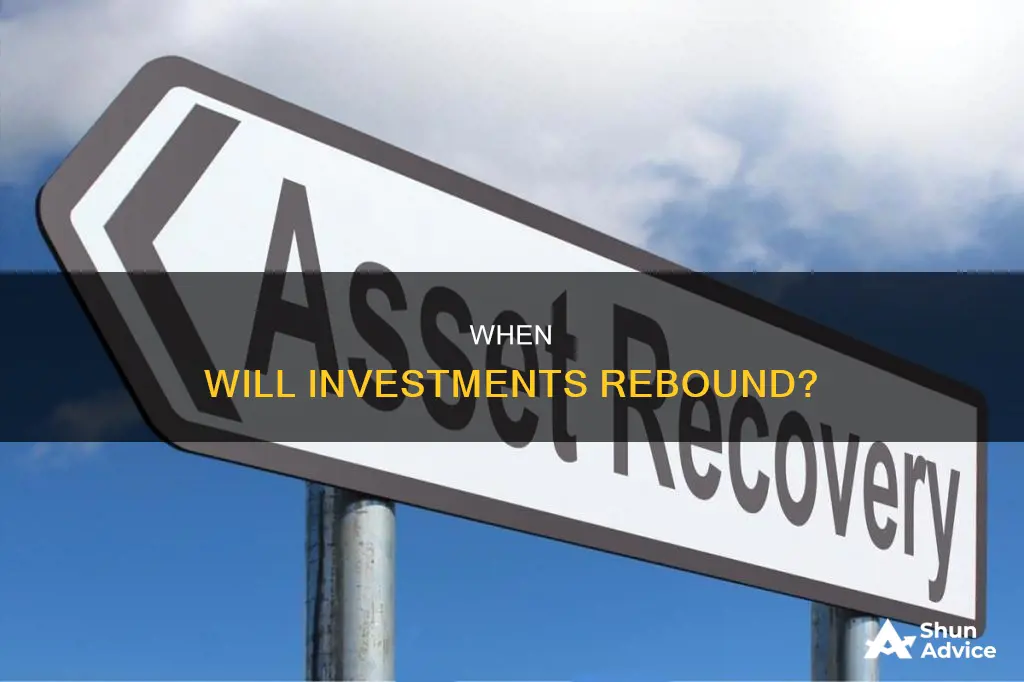
The amount of time it takes for investments to recover depends on a variety of factors, including the type of investment, market conditions, and individual circumstances. Historical data can provide valuable insights, but it's important to remember that past performance doesn't guarantee future results. On average, stock market pullbacks since 1956 have lasted just under a year, with recoveries typically taking longer than the initial decline. The severity of the loss also plays a role, with larger losses often requiring more time to recoup. Additionally, the time it takes to break even on an investment is known as the payback period, which is calculated by dividing the initial investment by the average annual cash flow.
| Characteristics | Values |
|---|---|
| How long will it take for investments to recover? | It depends on the type of investment, the amount of money invested, and the annual cash flow. |
| Average recovery time for stock market crashes | 19 months since 1950 |
| Recovery time for stock market crashes of less than 22% | 7 months |
| Recovery time for stock market crashes of more than 22% | 27 months |
| Payback period | The amount of time it takes to recover the cost of an investment or reach a breakeven point |
| Factors affecting recovery time | The amount of savings and the rate of market growth |
| Historical data | Can be used to estimate recovery times, but may not be accurate due to changing economic conditions |
What You'll Learn

Historical data can be used to predict recovery times
Historical data can be a valuable gut check for worst-case scenarios. For example, historical data shows that not all bear markets lead to long-term downturns, and stocks can often rebound quite quickly. In addition, historical recovery times can help investors determine an appropriate holding period for different types of funds. For instance, stocks have typically bounced back within 10 years, but it is better to err on the side of caution.
Historical data can also be used to set reasonable expectations for how long it might take various asset classes to bounce back. For example, the recovery period for U.S. stocks has been as long as 15 years, while gold has taken more than 26 years to recover in the past. Historical data can also be used to make sure portfolio holdings line up with the timing of an investor's goals.
It is important to note that past results do not necessarily predict future returns, and that the older the historical data, the less likely it is to be successful at forecasting returns in the future.
Federal Retirement Funds: Unlocking Investment Strategies
You may want to see also

The longer the recovery time, the greater the risk
When it comes to investments, timing the market is incredibly difficult. Watching market prices decline can be challenging, and it's important to remember that not all bear markets lead to long-term downturns. Stocks can often rebound quite quickly. If investors sell when the market is down, they will realise an actual loss. However, if they hold on to their investments and wait for the upturn, they won't lose anything.
Historical data can be a valuable indicator for worst-case scenarios. By reviewing historical recovery times, investors can gain insight into reasonable expectations for how long it might take various asset classes to bounce back. This data can also help ensure that an investor's portfolio aligns with their goals and risk tolerance.
Historical data is not a perfect guide, as there are no guarantees that the future will mirror the past. Asset classes that once seemed invincible, such as gold, bonds, and technology stocks, can experience dramatic changes in fortune. However, historical data is one of the few tools investors have to make decisions and prepare for potential worst-case scenarios.
Retired and Investing: Navigating the Golden Years with a Financial Edge
You may want to see also

Savings and market growth are key to recovery
The length of time it takes for investments to recover depends on various factors, including the performance of the market, the asset class, and the overall economic conditions. While it's challenging to predict exact recovery timelines, a combination of savings strategies and market growth can play a crucial role in speeding up the recovery process. Here's how savings and market growth are key to investment recovery:
Impact of Savings on Recovery
Personal savings are not just essential for an individual's financial stability but also have a broader impact on the economy. A high personal savings rate can accelerate a country's economic recovery from downturns. Savings provide a cushion that helps individuals weather financial storms without accumulating debt or defaulting on their financial obligations. This, in turn, reduces the strain on the economy and enables it to recover more quickly.
During economic downturns, individuals with higher savings are better equipped to manage their living expenses and adjust their budgets. They can continue meeting their financial commitments, such as mortgage payments, without resorting to drastic spending cuts. This ability to cope with financial hardships helps stabilize the economy, ensuring that businesses stay afloat and people remain employed.
Additionally, countries with higher national savings rates are less dependent on foreign direct investment. This reduces the risk associated with volatile foreign investment flows and enhances the stability of the domestic economy.
Market Growth and Recovery
Market growth is a critical factor in investment recovery. Historical data shows that markets tend to recover over time, and stocks often rebound quickly after a downturn. Analyzing historical recovery times for different asset classes can provide valuable insights for investors. While past performance doesn't guarantee future results, it helps set reasonable expectations and guides investment strategies.
Diversification is a key strategy to protect against losses and promote recovery. Diversifying investment portfolios across different asset classes, such as stocks, bonds, commodities, and real estate, can shield investors from the full impact of market downturns. Different asset classes perform differently during various economic cycles, so a well-diversified portfolio can smooth out the effects of volatility.
It's important to remember that market growth and recovery are influenced by numerous factors, including interest rates, inflation, supply and demand, and broader economic trends. Staying invested during market downturns and making investment decisions aligned with long-term goals can put investors in a better position to benefit from market growth and recovery.
Self-Employed Retirement Investing: Navigating Your Options
You may want to see also

Recovery times vary depending on investment type
Recovery times vary depending on the type of investment. Historical data can be a valuable indicator for investors, although it is not always a reliable predictor of future performance.
For example, the recovery time for US stocks following the 1929 Crash was 15 years, whereas the average recovery time for large-blend funds is around six months. The longest recovery period for large-blend funds was over six years.
The length of recovery time also depends on the severity of the market decline. Since 1950, stock market pullbacks have typically recovered their losses within 19 months of markets bottoming out on average. When stock markets decline less than 22%, the average recovery time is seven months. However, when stock markets decline by more than 22%, the recovery time increases to an average of 27 months.
The payback period, which is the length of time it takes to recover the cost of an investment, is an important metric for investors and corporations. A shorter payback period indicates a more attractive investment. The payback period can be calculated by dividing the amount of the investment by the annual cash flow.
It is worth noting that the payback period has some limitations, such as disregarding the time value of money and not accounting for the overall profitability of an investment. Other methods, such as net present value (NPV) and internal rate of return (IRR), can be used in conjunction with the payback period to make more informed investment decisions.
Doge Investors: Why the Hype?
You may want to see also

The payback period is a useful metric for investors
The payback period is favoured by investors as it helps them to assess the risk of an investment. Generally, shorter payback periods are considered more attractive investments as they expose the investor to less risk. Longer payback periods are less desirable as they indicate that it will take longer for the investor to recoup their initial investment. For example, an investment with a payback period of 4.2 years is generally considered a pretty good payback period. However, it is worth noting that the shortest possible payback period is the most desirable, and this can vary depending on the type of project or investment. For instance, the payback period for a home improvement project can be decades, whereas the payback period for a construction project may be five years or less.
One of the drawbacks of the payback period is that it does not take into account the overall profitability of the investment. It only considers the time taken to recoup the initial investment and ignores any benefits that occur after this point. Additionally, the payback period calculation does not account for the time value of money, which suggests that money is worth more today than the same amount in the future due to its earning potential. Despite these limitations, the payback period is still a useful metric for investors, especially when used in conjunction with other tools such as return on investment (ROI), internal rate of return (IRR), or net present value (NPV).
Historical data on recovery times can also be a valuable tool for investors to set reasonable expectations for how long it might take their investments to bounce back. This data can help investors make decisions about their portfolio holdings and ensure they align with their goals and risk tolerance. While it is important to remember that historical data is an imperfect guide, it is one of the few tools investors have to make informed choices.
The Smart Money Move: Pay Off Debt or Invest?
You may want to see also
Frequently asked questions
The time it takes for investments to recover depends on the type of investment, the market conditions, and the individual's financial situation. Historical data can be used to estimate recovery times, but it's not a perfect indicator. On average, stock market pullbacks since 1956 have lasted just under 1 year, with recoveries taking place within 19 months on average.
The two main factors that influence recovery time are the amount you can save and the rate of market growth. Larger contributions to your investments and higher market growth rates will lead to faster recovery.
The payback period is calculated by dividing the initial investment by the average annual cash flow. A shorter payback period indicates a more attractive investment.
Yes, there are calculators available, such as the Time to Recover Calculator, that use historical data to provide an estimate of how long it will take your investments to recover from a market downturn.
It's important to have a long-term investment horizon, typically ten years or more, when investing in stocks. Diversifying your portfolio and adjusting it according to your risk tolerance and goals can help protect against volatility and other risks. Seeking advice from a financial advisor or planner can also be beneficial.







